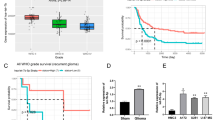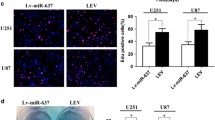Abstract
Gliomas are the most common central nervous system tumours; they are highly aggressive and have a poor prognosis. RGS16 belongs to the regulator of G-protein signalling (RGS) protein family, which plays an important role in promoting various cancers, such as breast cancer, pancreatic cancer, and colorectal cancer. Moreover, previous studies confirmed that let-7c-5p, a well-known microRNA, can act as a tumour suppressor to regulate the progression of various tumours by inhibiting the expression of its target genes. However, whether RGS16 can promote the progression of glioma and whether it is regulated by miR let-7c-5p are still unknown. Here, we confirmed that RGS16 is upregulated in glioma tissues and that high expression of RGS16 is associated with poor survival. Ectopic deletion of RGS16 significantly suppressed glioma cell proliferation and migration both in vitro and in vivo. Moreover, RGS16 was validated as a direct target gene of miR let-7c-5p. The overexpression of miR let-7c-5p obviously downregulated the expression of RGS16, and knocking down miR let-7c-5p had the opposite effect. Thus, we suggest that the suppression of RGS16 by miR let-7c-5p can promote glioma progression and may serve as a potential prognostic biomarker and therapeutic target in glioma.
Similar content being viewed by others
References
Dunn GP, Rinne ML, Wykosky J, Genovese G, Quayle SN, Dunn IF, Agarwalla PK, Chheda MG, Campos B, Wang A, Brennan C, Ligon KL, Furnari F, Cavenee WK, Depinho RA, Chin L, Hahn WC. Emerging insights into the molecular and cellular basis of glioblastoma. Genes Dev 2012; 26(8): 756–784
Villa C, Miquel C, Mosses D, Bernier M, Di Stefano AL. The 2016 World Health Organization classification of tumours of the central nervous system. Presse Med 2018; 47(11–12): e187–e200
Bray F, Ferlay J, Soerjomataram I, Siegel RL, Torre LA, Jemal A. Global cancer statistics 2018: GLOBOCAN estimates of incidence and mortality worldwide for 36 cancers in 185 countries. CA Cancer J Clin 2018; 68(6): 394–424
Chen J, McKay RM, Parada LF. Malignant glioma: lessons from genomics, mouse models, and stem cells. Cell 2012; 149(1): 36–47
Ross EM, Wilkie TM. GTPase-activating proteins for heterotrimeric G proteins: regulators of G protein signaling (RGS) and RGS-like proteins. Annu Rev Biochem 2000; 69(1): 795–827
Druey KM, Blumer KJ, Kang VH, Kehrl JH. Inhibition of G-protein-mediated MAP kinase activation by a new mammalian gene family. Nature 1996; 379(6567): 742–746
Liang G, Bansal G, Xie Z, Druey KM. RGS16 inhibits breast cancer cell growth by mitigating phosphatidylinositol 3-kinase signaling. J Biol Chem 2009; 284(32): 21719–21727
Johnson EN, Seasholtz TM, Waheed AA, Kreutz B, Suzuki N, Kozasa T, Jones TL, Brown JH, Druey KM. RGS16 inhibits signalling through the G alpha 13-Rho axis. Nat Cell Biol 2003; 5(12): 1095–1103
Berthebaud M, Rivière C, Jarrier P, Foudi A, Zhang Y, Compagno D, Galy A, Vainchenker W, Louache F. RGS16 is a negative regulator of SDF-1-CXCR4 signaling in megakaryocytes. Blood 2005; 106(9): 2962–2968
Carper MB, Denvir J, Boskovic G, Primerano DA, Claudio PP. RGS16, a novel p53 and pRb cross-talk candidate inhibits migration and invasion of pancreatic cancer cells. Genes Cancer 2014; 5(11–12): 420–435
Miyoshi N, Ishii H, Sekimoto M, Doki Y, Mori M. RGS16 is a marker for prognosis in colorectal cancer. Ann Surg Oncol 2009; 16(12): 3507–3514
Sun X, Charbonneau C, Wei L, Chen Q, Terek RM. miR-181a targets RGS16 to promote chondrosarcoma growth, angiogenesis, and metastasis. Mol Cancer Res 2015; 13(9): 1347–1357
Sayed D, Abdellatif M. MicroRNAs in development and disease. Physiol Rev 2011; 91(3): 827–887
Calin GA, Croce CM. MicroRNA signatures in human cancers. Nat Rev Cancer 2006; 6(11): 857–866
Fu X, Mao X, Wang Y, Ding X, Li Y. Let-7c-5p inhibits cell proliferation and induces cell apoptosis by targeting ERCC6 in breast cancer. Oncol Rep 2017; 38(3): 1851–1856
Huang M, Gong X. Let-7c inhibits the proliferation, invasion, and migration of glioma cells via targeting E2F5. Oncol Res 2018; 26(7): 1103–1111
Wen PY, Kesari S. Malignant gliomas in adults. N Engl J Med 2008; 359(5): 492–507
Huang R, Li G, Zhao Z, Zeng F, Zhang K, Liu Y, Wang K, Hu H. RGS16 promotes glioma progression and serves as a prognostic factor. CNS Neurosci Ther 2020; 26(8): 791–803
Chu I, Sun J, Arnaout A, Kahn H, Hanna W, Narod S, Sun P, Tan CK, Hengst L, Slingerland J. p27 phosphorylation by Src regulates inhibition of cyclin E-Cdk2. Cell 2007; 128(2): 281–294
Choe G, Horvath S, Cloughesy TF, Crosby K, Seligson D, Palotie A, Inge L, Smith BL, Sawyers CL, Mischel PS. Analysis of the phosphatidylinositol 3′-kinase signaling pathway in glioblastoma patients in vivo. Cancer Res 2003; 63(11): 2742–2746
Wang L, Zhang ZG, Zhang RL, Gregg SR, Hozeska-Solgot A, LeTourneau Y, Wang Y, Chopp M. Matrix metalloproteinase 2 (MMP2) and MMP9 secreted by erythropoietin-activated endothelial cells promote neural progenitor cell migration. J Neurosci 2006; 26(22): 5996–6003
Fan QW, Cheng C, Hackett C, Feldman M, Houseman BT, Nicolaides T, Haas-Kogan D, James CD, Oakes SA, Debnath J, Shokat KM, Weiss WA. Akt and autophagy cooperate to promote survival of drug-resistant glioma. Sci Signal 2010; 3(147): ra81
Suzuki Y, Shirai K, Oka K, Mobaraki A, Yoshida Y, Noda SE, Okamoto M, Suzuki Y, Itoh J, Itoh H, Ishiuchi S, Nakano T. Higher pAkt expression predicts a significant worse prognosis in glioblastomas. J Radiat Res (Tokyo) 2010; 51(3): 343–348
Choe G, Horvath S, Cloughesy TF, Crosby K, Seligson D, Palotie A, Inge L, Smith BL, Sawyers CL, Mischel PS. Analysis of the phosphatidylinositol 3′-kinase signaling pathway in glioblastoma patients in vivo. Cancer Res 2003; 63(11): 2742–2746
Mure H, Matsuzaki K, Kitazato KT, Mizobuchi Y, Kuwayama K, Kageji T, Nagahiro S. Akt2 and Akt3 play a pivotal role in malignant gliomas. Neuro-oncol 2010; 12(3): 221–232
Quail DF, Joyce JA. The microenvironmental landscape of brain tumors. Cancer Cell 2017; 31(3): 326–341
Jansson MD, Lund AH. MicroRNA and cancer. Mol Oncol 2012; 6(6): 590–610
Esquela-Kerscher A, Slack FJ. Oncomirs—microRNAs with a role in cancer. Nat Rev Cancer 2006; 6(4): 259–269
Piwecka M, Rolle K, Belter A, Barciszewska AM, Żywicki M, Michalak M, Nowak S, Naskręt-Barciszewska MZ, Barciszewski J. Comprehensive analysis of microRNA expression profile in malignant glioma tissues. Mol Oncol 2015; 9(7): 1324–1340
Acknowledgements
This work was supported by grants from the National Natural Science Foundation of China (Nos. 81874083, 82072776, 82072775, 81702468, 81802966, 81902540, 81874082, and 81472353), Natural Science Foundation of Shandong Province of China (Nos. ZR2019BH057, ZR2020QH174, and ZR2021LSW025), the Jinan Science and Technology Bureau of Shandong Province (No. 2021GXRC029), Key Clinical Research Project of Clinical Research Center of Shandong University (No. 2020SDUCRCA011) and Taishan Scholars of Shandong Province of China (No. tspd20210322), and Scientific Research Foundation of Qilu Hospital (Qingdao) (No. QDKY2019QN03).
Author information
Authors and Affiliations
Corresponding authors
Ethics declarations
Chaochao Wang, Hao Xue, Rongrong Zhao, Zhongzheng Sun, Xiao Gao, Yanhua Qi, Huizhi Wang, Jianye Xu, Lin Deng, and Gang Li declare that they have no conflict of interest. All institutional and national guidelines for the care and use of laboratory animals were followed.
Electronic supplementary material
Rights and permissions
About this article
Cite this article
Wang, C., Xue, H., Zhao, R. et al. RGS16 regulated by let-7c-5p promotes glioma progression by activating PI3K-AKT pathway. Front. Med. 17, 143–155 (2023). https://doi.org/10.1007/s11684-022-0929-y
Received:
Accepted:
Published:
Issue Date:
DOI: https://doi.org/10.1007/s11684-022-0929-y




